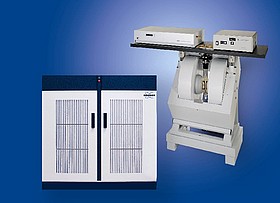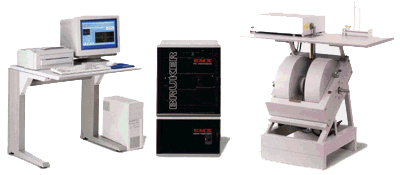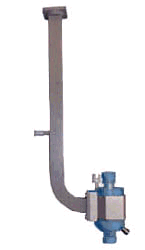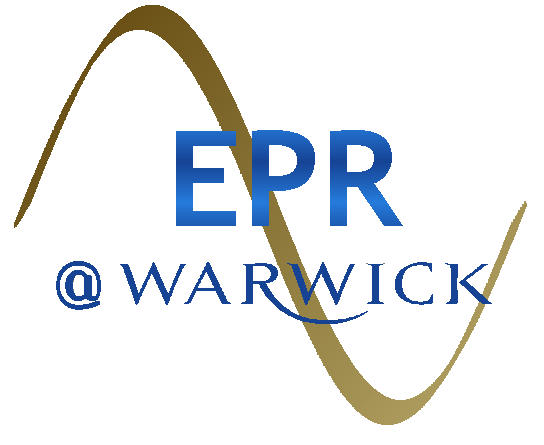EPR and ENDOR Spectrometers
The group’s facilities include five modern EPR spectrometers.
BRUKER E580 FT/CW (X-BAND/Q-BAND)

- FT-EPR and Electron Spin Echo techniques as the basic detectors for the EPR spectrum and electron spin relaxation times
- ESEEM and 2D-HYSCORE to measure spin density distribution and distances through the hyperfine interaction between electron and nuclear spins
- SECSY and EXSY to measure correlations and exchange rates
- Pulse-ELDOR and DEER to measure long range distances by electron-electron spin dipolar coupling
- Pulse-ENDOR to measure hyperfine interactions and nuclear spin relaxation
- Laser triggered experiments and ODMR
BRUKER E680 FT/CW (W-BAND)
Our ELEXSYS E680 is equipped for High-Frequency/High-Field CW/pulsed EPR and ENDOR at 94 GHz. Experiments can be performed at temperatures between 3.7 and 300 K. For high power DNP experiments the system performance is enhanced with a 100 W EIK microwave amplifier.
Two Bruker EMX (X-band)

This EMX spectrometer operates at 9.2 - 9.8 GHz with a microwave bridge incorporating the latest state-of-the-art technology to provide the highest sensitivity measurements. This microwave bridge is fully remotely controlled and provides coarse frequency
readout to 3 digits (or to a resolution of 1 kHz with external frequency counter), protection against damage through user error, output power (max 200 mw levelled) can be stepped in 1dB increments (with an accuracy of typically /- 0.2 dB from 0 dB to 60 dB), direct digital power readout in mW, µW, or nW and incorporates a high dynamic range AFC frequency lock, with frequency response and gain matched to the source oscillator characteristics.
The spectrometer in standard configuration is equipped with a Bruker Super High QE (SHQE) cavity resonator (ER 4123SHQE). The quality factor (Q) of the resonator acts like an amplifier for both the incident power and the signal. Generally, a higher Q means higher sensitivity. However, you also need to consider the cavity's filling factor and the quality of the microwave source. The filling factor is the ratio of the integral of the microwave field over the sample volume relative to the integral of the total microwave field in the cavity. Classical high Q cavities such as the cylindrical TE011 have relatively poor filling factors, thus reducing the effect of their high Q. The new Bruker Super High QE (SHQE) cavity combines a super high Q (Qu>25000) with a large filling factor and large modulation coils. Combined with a specially tuned low noise Gunn source bridge, and the SignalMaster, the SHQE provides the ultimate in sensitivity. The cavity provides outstanding performance with powder, single crystal and even aqueous samples. Its autotune capabilities make it as easy to use as a standard cavity.
The spectrometer is equipped with an ER070 Bruker magnet and ER080 magnet power supply. The pole gap is 62 mm and the maximum attainable field is approximately 0.64 Tesla. The E 032 field controller provides accurate field control with excellent long term stability, allowing you to signal average extensively to pull your weak signals out of the noise. The accuracy of this unit is unparalleled for Hall effect based field controllers, providing you with precise and reproducible measurement of line widths, splittings and g-values. The field controller is calibrated against an NMR gaussmeter. The calibration is loaded into the memory of the controller to guarantee a highly linear field sweep. The EMX 032 provides full sweep capability in the range of 0 to maximum field in 50 mG steps with a resolution of 12 bits. Any errors or drift from temperature effects at the hall probe are avoided by active temperature control of the Hall probe.
This EMX has a single signal channel, operating between 6 and 100 kHz with excellent phase resolution and stability. The modulation frequency can be set with a resolution of 0.01 kHz. Measurement reproducibility and precision, essential for any quantitative EPR study, are ensured even for the novice user through precise calibration of the modulation amplitude and phase. The calibration routine automatically calibrates these quantities and stores them on hard disk for future use. Automatic digital tuning of the modulation coils (at frequencies greater than 50 kHz) eliminates the need for the classical 'tuning box' for each cavity.
Accessories for (i) variable temperature EPR (1.5−1200 K); (ii) optically excited EPR (200−1100 nm); (iii) electron nuclear double resonance (ENDOR); and (iv) precise sample orientation automated using one and two circle goniometers are available.
Bruker EMX (X-band and Q-band)
This spectrometer is equipped with a choice of X-band and Q-band bridges and microwave resonators. The X-band bridge is similar to that used with the other Bruker EMX spectrometer in the group, and can be used with a choice of a Bruker Super High QE (SHQE) cavity resonator (ER 4123SHQE), Double Rectangular Resonator (ER 4105DR), TM110 ENDOR Resonator, and a variety of Loop Gap Resonators (LRG). The Double Rectangular Resonator is used for the determination of the spin concentrations as well as the g-factor measurement against a reference sample. It is composed of a double cavity with a maximum sample access of 10.5 mm, and is used primarily for quantitative experiments. The main feature of the cavity is that both samples experience the same microwave field, since the two cavities are coupled. Both chambers are equipped with separated modulation coils as well as rapid scan coils. The chamber in the front has optical access to the cavity, with 50% transmission for incident light.
The Bruker Q-band bridge (33.85-34.15 GHz) can supply more than 100 mW of low noise microwave power and is used with a Bruker variable temperature resonator (ER5102QT), or a variety of home made Q-band resonators for high-sensitivity measurements of small samples, g-value measurements, as well as multi-frequency studies. The Bruker resonator is operated in ether the TE011 or TE012 modes providing useful experimental flexibility.
This spectrometer is equipped with a Bruker ER 073 electromagnet and an ER 083 power supply. The magnet has pole caps 10 inch (25cm) in diameter, an air gap of 56 mm, weighs 1700 kg and can generate a maximum field of 1.7 Tesla. This magnet offers excellent magnetic field homogeneity (useful for the study of samples and with very narrow lines). The power supply has a main power switch and overload warning signals for line supply, phase failure, current overload, cooling water failure and temperature loss. The system has been enhanced with an electronic leak detection system, such that the cooling water is automatically shut off should a leak be detected.
The system is controlled using an EMX field controller and signal channel, operating between 6 and 100 kHz with excellent phase resolution and stability. The modulation frequency can be set with a resolution of 0.01 kHz. Measurement reproducibility and precision, essential for any quantitative EPR study, are ensured even for the novice user through precise calibration of the modulation amplitude and phase. The calibration routine automatically calibrates these quantities and stores them on hard disk for future use. Automatic digital tuning of the modulation coils (at frequencies greater than 50 kHz) eliminates the need for the classical 'tuning box' for each cavity.
Accessories for (i) variable temperature EPR (1.5−1200 K); (ii) optically excited EPR (200−1100 nm); (iii) optically detected EPR, (iv) electron nuclear double resonance (ENDOR); and (v) precise sample orientation automated using one and two circle goniometers are available.
Collaboration
If you are interested in using any of our EPR facilities then please contact Mark Newton (m.e.newton@warwick.ac.uk) for further information.

We also have in house expertise in spectral simulation and analysis, if you think we can help please contact Mark Newton.
